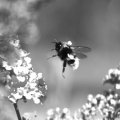Student finds something fishy about UV
University of Queensland PhD student Ulrike Siebeck puts mermaids to shame in her diving and fish-catching abilities.
The second year PhD student with the Vision, Touch and Hearing Research Centre has just returned from a Northern Hemisphere summer catching and analysing the vision abilities of hundreds of coral reef and deep sea fish.
Ms Siebeck is examining the ability of some fish to detect an extra colour located in the ultra-violet spectrum.
"Invisible to human eyes, we can't even imagine the colour. Furthermore the colour blends with others to form a myriad of shades," she said.
Supervised by the Centre's QEII research fellow, Dr Justin Marshall, her thesis explores the reasons why some fish have the ability to see the extra colour. "Of the 300 fish species I have analysed from the Great Barrier Reef and the additional 100 from my trip to Florida, I have found roughly one-third with this ability," she said.
"UV is a hot topic with fears of the damage this form of light does to coral reefs. We are interested in what good it does, how many fish use UV colouration in their daily lives. We believe they use it to help them select mates and find food. It is especially prevalent in fish who eat plankton. We believe the colour may allow these fish to more readily see the tiny particles in the ocean."
Funded by the Physiology and Pharmacology Department and Dr Marshall, Ms Siebeck was part of the surface boat team supporting Dr Marshall's recent nine-day stay in the Aquarius - a permanent structure anchored 20 metres under the sea in the Florida Keys National Marine Sanctuary. "I would swim down a couple of times a day to collect the fish he caught and bring them back to the surface boat for laboratory analysis. I also caught many fish by herding them into a barrier net," Ms Siebeck said.
She then spent several weeks on the Johnson Sea Link - an ocean-going boat with attached submarine - which operates out of the Harbor Branch Oceanographic Institute at Fort Pierce, Florida. During this trip, she travelled to depths of 800 metres in the submarine around Oceanographer's Canyon.
"I was interested to see what kind of deep sea fish we would catch and how their eyes would compare to more shallow-living species. I expected differences as there is hardly any sunlight left from 400 metres onwards and the light at those depths is actually produced by organisms with special light organs," she said.
German-born Ms Siebeck said she first became fascinated with marine life at age 10 when she visited the Australian Marine Institute in Townsville with her father. She studied one year of marine biology at the University of Queensland in 1994-95 as part of an exchange arrangement with Tubingen University in south-west Germany.
For more information, contact Ulrike Siebeck (telephone 07 3365 1617).



